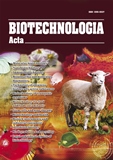ISSN 2410-7751 (Print)
ISSN 2410-776X (Online)

Biotechnologia Acta Т. 17, No. 2 , 2024
P. 33-35, Bibliography 4, Engl.
UDC:577 + 616-001
DOI: https://doi.org/10.15407/biotech17.02.033
HEPARIN-BINDING EGF–LIKE GROWTH FACTOR AS A PROSPECTIVE MEDIATOR OF TISSUE REPAIR AND REGENERATION
A.V. Didan 1,2, A.A. Siromolot 1,2, D.V. Kolybo 2
1 ESC “Institute of Biology and Medicine” of Taras Shevchenko National University of Kyiv, Ukraine
2 Palladin Institute of Biochemistry of the National Academy of Sciences of Ukraine, Kyiv
Aim. To obtain bioactive recombinant human HB-EGF and investigate its proliferation capacity.
Methods. The pET32(a)-HB-EGF cloning plasmid was extracted from E. coli DH10B cells and transformed into E. coli BL21 (DE3) Rosetta cells. The expression of HB-EGF was induced with IPTG and the protein was purified by metal-affinity chromatography with Co²⁺-NTA. Purified HB-EGF was analyzed by SDS-PAGE. The interaction of HB-EGF with receptors was analyzed by flow cytometry using A431 cells. The effect of HB-EGF on the proliferation of 3T3 and L929 fibroblast cell lines was accessed using the MTT assay.
Results. High-quality HB-EGF was obtained through an optimized protocol involving plasmid purification, E. coli transformation, and protein purification. SDS-PAGE confirmed the purity of HB-EGF. Flow cytometry validated the binding of EGFP-HB-EGF to A431 cell receptors. The MTT assay data showed that HB-EGF significantly promoted the proliferation of 3T3 cells in a dose-dependent manner, with a 67% and 112% increase in cell density in the presence of 500 ng/mL and 1000 ng/mL of HB-EGF, respectively. No significant changes in the proliferation of L929 cells were observed under the same concentrations of HB-EGF.
Conclusions. We have successfully optimized a protocol to produce and purify biologically active HB-EGF in E. coli. The bioactivity of HB-EGF was validated in A431 and 3T3 cell lines, demonstrating its potential to interact with receptors and significantly increase cell proliferation. This bioactive HB-EGF can be potentially used for tissue repair and regeneration.
Key word: HB-EGF, recombinant protein, proliferation, tissue repair.
REFERENCES
1. Krynina O. I., Korotkevych N. V., Labyntsev A. J., Romaniuk S. I., Kolybo D. V., Komisaren ko S. V.
“Influence of Human HB-EGF Secreted Form on Cells with Different EGFR and ErbB4 Quantity.”
The Ukrainian Biochemical Journal. 2019, 91 (5), 25–33, https://doi.org/10.15407/ubj91.05.025
2. Dao D. T., Anez-Bustillos L., Adam R. M., Puder M., Bielenberg D. R. Heparin-Binding
Epidermal Growth Factor-Like Growth Factor as a Critical Mediator of Tissue Repair and
Regeneration. The American journal of pathology 2018, 188(11), 2446–2456. https://doi.
org/10.1016/j.ajpath.2018.07.016
3. Khalili M., Soleyman M. R., Baazm M., Beyer, C. High-level expression and purification of soluble
bioactive recombinant human heparin-binding epidermal growth factor in Escherichia coli. Cell
Biology International 2015, 39(7), 858–864. https://doi.org/10.1002/cbin.10454
4. Adhirajan N., Thanavel R., Naveen N, Uma N.S., Babu M.. “Functionally Modified Gelatin
Microspheres as a Growth Factor’s Delivery System: Development and Characterization.” Polymer
Bulletin, 2014, 71 (4), pp. 1015–1030, https://doi.org/10.1007/s00289-014-1108-3
© Palladin Institute of Biochemistry of National Academy of Sciences of Ukraine, 2024

